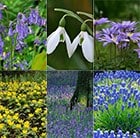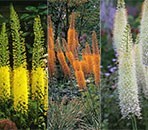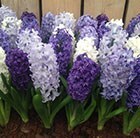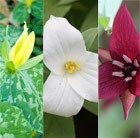When to Plant
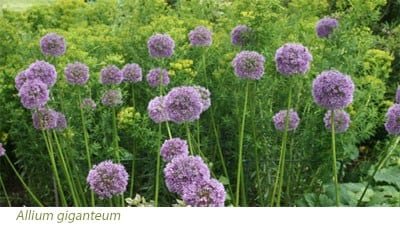 Plant alliums, daffodils, scillas, crocus, muscari, snowdrops, winter aconites (Eranthis), erythronium, outdoor hyacinths and lilies in September and October. Plant alliums, daffodils, scillas, crocus, muscari, snowdrops, winter aconites (Eranthis), erythronium, outdoor hyacinths and lilies in September and October.
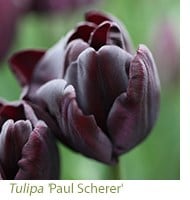 Tulips are the exception though. They are planted once the temperatures fall because they are prone to a fungal disease called tulip fire (Botrytis tulipae), which spreads more easily in warm weather. This stunts the bulbs, and streaks the foliage and flowers in unsightly whitish-grey marks. If you succumb you will have to leave a gap of five years before planting in the same place again. For this reason tulip bulbs must be planted in colder weather, usually from November right up until Christmas. Some gardeners prefer to plant them in containers to lessen the chance of getting the disease in their soil and tulips do shine, lifted up to new heights in weather-proof containers. Tulips are the exception though. They are planted once the temperatures fall because they are prone to a fungal disease called tulip fire (Botrytis tulipae), which spreads more easily in warm weather. This stunts the bulbs, and streaks the foliage and flowers in unsightly whitish-grey marks. If you succumb you will have to leave a gap of five years before planting in the same place again. For this reason tulip bulbs must be planted in colder weather, usually from November right up until Christmas. Some gardeners prefer to plant them in containers to lessen the chance of getting the disease in their soil and tulips do shine, lifted up to new heights in weather-proof containers.
How to Plant
The rule of thumb is to plant them between twice and three times the depth of the bulb. A small trowel or bulb planter is useful.
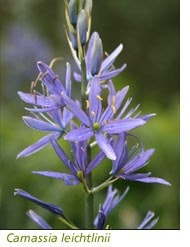 When naturalising in grass it is useful to lift two sides of a triangle of turf (30 x 30cm) with a spade so that you have a v-shaped flap of grass attached to the main sward. Take a fork and carefully break up the newly exposed triangle of soil that was under the grass. Plant your bulbs in the triangle and then pull the flap of grass (that is going to cover them) with your hands to break it up a little. This will make it easier for the bulbs to penetrate the grass when they start growing in late winter and spring. Tread it back down carefully - it may look a little bumpy to start with, but will soon settle. Camassia leichtlinii does very well in grass, generally following daffodils with spires of deep-blue stars studded with upturned yellow anthers. When naturalising in grass it is useful to lift two sides of a triangle of turf (30 x 30cm) with a spade so that you have a v-shaped flap of grass attached to the main sward. Take a fork and carefully break up the newly exposed triangle of soil that was under the grass. Plant your bulbs in the triangle and then pull the flap of grass (that is going to cover them) with your hands to break it up a little. This will make it easier for the bulbs to penetrate the grass when they start growing in late winter and spring. Tread it back down carefully - it may look a little bumpy to start with, but will soon settle. Camassia leichtlinii does very well in grass, generally following daffodils with spires of deep-blue stars studded with upturned yellow anthers.
Once your bulbs are established make sure that you do a thorough tidy in early September, just before your dormant bulbs begin to re-root and grow again.
The Aesthetics
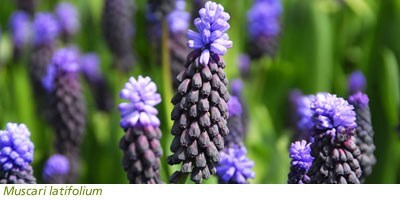
When arranging bulbs it’s best to plant the earlier flowering bulbs (such as daffodils, muscari and crocus) away from later-flowering tulips. Otherwise by the time your tulips flower, the daffodils etc. will be over and may spoil the show by looking ragged.
Always go for a natural look and avoid planting in straight lines or blobs. If using only one variety randomly sprinkle them across the ground and plant where they fall so they are close together, but not right next to each other. Using one variety of any bulb shortens the show however as they will all flower at the same time, giving only two weeks of flower in an average year. For this reason it’s a good idea to combine four or five varieties (or more) of each type of bulb, some earlier and some later. Then it’s possible to have early spring bulbs from January until May. The best way to extend your display and make it look good is to restrict yourself to three or four varieties, but plant them in quantity to avoid a pincushion effect.
Start Early in Shade or Sun
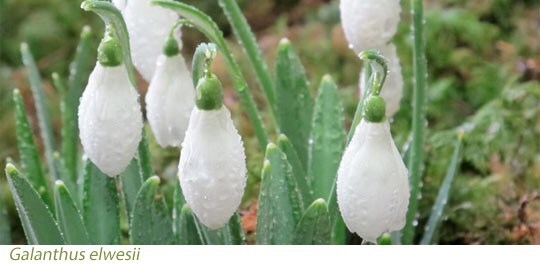
Include some of the earliest bulbs, including a ground-hugging scilla with an impossible Russian name - Scilla mischtschenkoana. This miniature bulb, originally collected in the 1930s, will flower with the snowdrops and aconites, like a snowflake against the bare earth, looking best in shade. It’s not planted nearly enough.
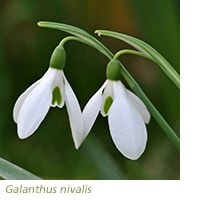 Make sure you find room for the snowdrop and the winter aconite as well. The boldest snowdrop of all is Galanthus elwesii. Its glaucous, blunt-topped leaves indicate a preference for a brighter spot to promote early flowers, so a woodland edge or an open position is best. The handsome green markings on the single flowers, which often appear in January, are variable, adding further interest. And the large bulbs increase well too. Make sure you find room for the snowdrop and the winter aconite as well. The boldest snowdrop of all is Galanthus elwesii. Its glaucous, blunt-topped leaves indicate a preference for a brighter spot to promote early flowers, so a woodland edge or an open position is best. The handsome green markings on the single flowers, which often appear in January, are variable, adding further interest. And the large bulbs increase well too.
Most people will long to grow our most common snowdrop Galanthus nivalis. This is more of a woodlander, preferring cool shade. There are elegant single forms and frilly doubles labelled 'Flore Pleno'. Their frilly middles force them to stay open, even on the dullest day. So although double flowered forms may not have the simple elegance of the singles, they do make more of a splash. A giant hybrid that can reach a foot in height,
'S. Arnott’, has pearl earrings for flowers, which when they open, smell of honey.
Early Flowering Sun Lovers
Add winter aconites (Eranthis hyemalis) too, but do find them a sunny and sheltered spot so that they open their flowers for the bees. Pollination will produce plump star-shaped capsules full of seeds and these will eventually produce a natural colony.
 The smaller-flowered crocus are never far behind the winter aconites and they share a love of sun. One jaunty little crocus combines purple petals ringed in white and egg-yolk yellow - Crocus sieberi subsp. sublimis 'Tricolor'. This could ring a tree, or pop up on a sunny corner and it has a charming habit of peeping through snow. The smaller-flowered crocus are never far behind the winter aconites and they share a love of sun. One jaunty little crocus combines purple petals ringed in white and egg-yolk yellow - Crocus sieberi subsp. sublimis 'Tricolor'. This could ring a tree, or pop up on a sunny corner and it has a charming habit of peeping through snow.
Shortly afterwards the many forms of small-flowered crocus appear and many have flamed outer petals to their tiny pastel-tinted flowers. Use these in warm, well-drained spots where the sun strikes. A mixed species packet will give you a toning selection of several varieties.
Larger crocus generally flower four weeks after the smaller crocus. They are bred from an alpine species, Crocus vernus, and are strong enough to be naturalised in grass. The truly beautiful 'Vanguard’ is much earlier, hence the name, and this vision of lilac and silver usually appears in February. It’s one bulb every gardener should grow, but it wasn’t available for many years. Take advantage now.
The Container
 If the budget’s tight or your plot is tiny, potting up a large container will make much more of an impact. It has to be rugged, either frost-proof terracotta, wood or stone, to withstand hard weather. Your compost has to be equally meaty and should contain loam to ballast the container and hold the nutrients. John Innes no.3 is an excellent choice. And you will need to pack your bulbs in more closely than you would in the garden. If the budget’s tight or your plot is tiny, potting up a large container will make much more of an impact. It has to be rugged, either frost-proof terracotta, wood or stone, to withstand hard weather. Your compost has to be equally meaty and should contain loam to ballast the container and hold the nutrients. John Innes no.3 is an excellent choice. And you will need to pack your bulbs in more closely than you would in the garden.
Once planted it's important not to get the bulbs waterlogged. Either cover your container with a plywood sheet or similar, or put the container in a dry position, against a north-facing wall or in the lee of the house. Once the bulbs have been in the container for six weeks they will have begun to root and then can be put in situ. Then a covering of chicken wire will keep off marauding squirrels.
Containers are moveable feasts. Should next spring be very warm it’s possible to move your container to a shadier position so that the flowers last longer. This can be a real advantage.
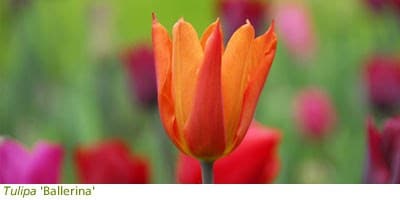
Tulips do well in
containers and the best scent of all belongs to a warm-orange lily-flowered tulip called 'Ballerina’. 'Veronique Sanson' is a similar colour to 'Ballerina’, but this Triumph tulip should flower two weeks earlier and be six inches shorter. Light the touchpaper colourwise and add the equally scented double early 'Margarita’ - a pink purple that will shine against 'Ballerina’.
Parrot tulips are also great in containers and they have the ability to change colour as their ruffled feather-like petals open, giving a long season of interest. 'Rococo’ is as stylish as its name suggests with carmine-red petals frosted in jade-green. The luscious 'Blue Parrot’ or the bronzed 'Ego Parrot’ are equally stunning whether grown alone or teamed up with small winter pansies or Anemone blanda.
Stunning Tulip Recipes
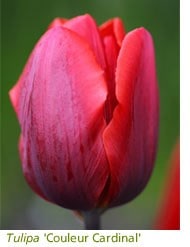 When planting always choose some Triumph tulips. These flower in the second half of April, two weeks before the later tulips, giving you a longer tulip season. They are shorter than most, usually 40-45cm, so they add a more natural look to your planting. Triumphs are the most sought-after by the cut flower trade too, and their bright flowers are smaller and thicker-petalled to shrug off the weather. Top varieties include the pink 'Mistress’, the beetroot-purple and white flamed 'Rem’s Favourite’, the warm-red 'National Velvet’, the blackcurrant 'Havran’, the purple 'Negrita’ and the exotic-looking red and plum 'Couleur Cardinal’. When planting always choose some Triumph tulips. These flower in the second half of April, two weeks before the later tulips, giving you a longer tulip season. They are shorter than most, usually 40-45cm, so they add a more natural look to your planting. Triumphs are the most sought-after by the cut flower trade too, and their bright flowers are smaller and thicker-petalled to shrug off the weather. Top varieties include the pink 'Mistress’, the beetroot-purple and white flamed 'Rem’s Favourite’, the warm-red 'National Velvet’, the blackcurrant 'Havran’, the purple 'Negrita’ and the exotic-looking red and plum 'Couleur Cardinal’.
Dark and Sultry

Dark, sultry tulips such as 'Queen of Night’ will disappear against the bare earth unless they are mixed with golds, pinks or pallid-yellows. Good golds to weave through dark tulips include 'Cairo' and 'Abu Hassan' and these work well with 'Jan Reus' a dark-red Triumph. Pinks and red-pinks could include the bright pinks ('Mistress', 'Don Quichotte' and 'Barcelona’) the red viridiflora 'Doll’s Minuet’, the pearly coral-pink 'New Design’ and the purple-flecked 'Shirley’.
The purple tulip 'Negrita’ is excellent used with the white flecked 'Shirley’ (which opens to cream at first - so don’t panic) either as a duo, or mixed with pinks. |























